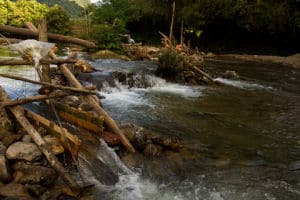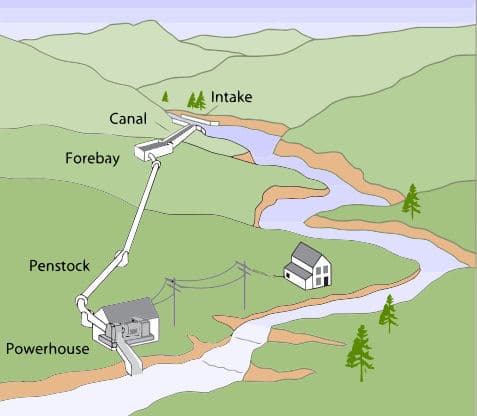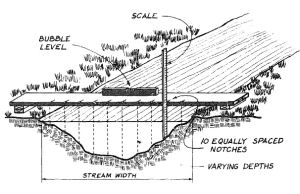
Micro Hydro Power
Low Pressure Micro Hydro Power
![]() Micro Hydro Power on a small-scale can be a cost-effective energy technology compared to solar photovoltaics if you have a river or stream nearby. Low pressure micro hydro schemes can be extremely robust generating electrical power for many years with little or no maintenance, and is also one of the cleanest sources of energy technologies available.
Micro Hydro Power on a small-scale can be a cost-effective energy technology compared to solar photovoltaics if you have a river or stream nearby. Low pressure micro hydro schemes can be extremely robust generating electrical power for many years with little or no maintenance, and is also one of the cleanest sources of energy technologies available.
We know from the tutorials in this website that Hydroelectric power, or Hydroelectricity, is generated by the force of falling water. The daily hydrologic cycle of water in which the evaporation of water from lakes and oceans, forms into clouds, then returning back to earth as rain or snow before flowing back again to the lakes and oceans.

The energy potential of this continuous water cycle driven by the sun can be harnessed and used more efficiently with micro hydro schemes as little or no water needs to be stored minimising any adverse effects on the local environment, unlike large scale hydro.
For large scale hydro energy production there are many existing schemes like, impoundment hydro power, overshot and undershot waterwheels as well as localised small-scale hydro power plants.
But the generation of hydro-electricity is usually associated with the building of artificial lakes and dams constructed from millions of tons of rocks, concrete and earth to block off any existing river flows.
A typical low pressure micro hydro installation on the other hand is, in most cases, run-of-river schemes which do not require water impoundment. Instead a small part of the flowing water from a river upstream is diverted downhill through various penstock design, pipes, tubes or canals to rotate a small water turbine before being returned back to the same river allowing it to be easily integrated with existing irrigation and water supply projects.
If properly designed, a micro hydro power generation scheme should a non-polluting, renewable resource causing minimal environmental disruption to both the river and the native ecology as any civil or building works used during construction only serve to regulating the water level at the intake therefore eliminating the same kinds of adverse effects to the local environment as would be the case with a large scale hydro scheme.
Micro hydro power is generally defined as the generation of electrical power from a few hundred watts to 10’s of kilo-watts (10kW) and is often considered to be a green form of energy because there are no harmful emissions associated with the generation of the electricity.
The following example image shows the main components of a typical run-of-river low pressure micro hydro scheme. River water is channelled to the turbine located in the powerhouse via a penstock. The turbine drives an electrical generator which provides electricity directly, DC for battery charging or via a transmission line to supply AC domestic power to a house or houses for lighting and power uses.
Low Pressure Micro Hydro Scheme

Of course there are many different ways, installations and alternative schemes for creating a low pressure micro-hydro system, but to determine the potential power that exists in the water flowing through a river, stream or even a ditch for you to use, you first need to understand both the flow rate (water velocity) of the water and the head height (vertical distance) from which the water has to fall.
Turning Water into Watts
In order to determine the minimum continuous power output you could expected from your micro hydro power scheme, you first need to understand the expected weekly, monthly or yearly flow rates for your river or stream. Your proposed site may have dry or low-level seasons as well as wet or high-level seasons. Thus it is important to know both the streams minimum flow rate and what portion of this water flow you will need for power generation, 10% or 50%, etc. as you may need local water agency permits if the portion of water take-off is too high.
Water Flow Rate
The water flow available to power your micro hydro power generator can be estimated using historic hydrology data of the site or the actual water flow can be physically measured. If your local water board or agency does not have historical records then it may be necessary to measure the water flow over a period of time during the planning stage, and there are many ways to measure the flow rate of the water.
Flow rate, that is water velocity, is the quantity of water that flows past a fixed point over a given time period. Typical flow rate units are given in: litres per second, Litres/sec, cubic metres per second, m3/s, cubic feet per second, ft3/s (or cfs) or gallons per minute, (gpm) and there are multiple types of commercial flow meters calibrated to any or all of these units.
How to Determine Water Flow Rate

The most common method of determining flow rate is to measure the cross-sectional area of a given part of the river, stream or ditch.
Measure the width at a given point from bank-to-bank and then the depth at equal intervals along the width. Measure the water depth at each interval to calculate the average depth of water.
Multiplying the width by the average measured depth will give you the cross-sectional area in whichever units you have used, feet or metres. If done carefully it will give you accurate results for most calculations.
Next the determination of the water velocity can be done by simply using something that floats. Mark two points along the same stretch of river or stream of a given distance, 10m, 50 feet, 20 yards, etc. place something that will float and move easily in the water at the first point or marker and measure the time it takes in seconds to reach the second marker. Repeating this process several times and average out the results.
Be mindful that this float method does not accurately represent the true velocity of all the water flowing past the two points as the water passing along the sides or bottom of the river or stream flow at a different speed than the water at the center or top were the float is due in part to the friction and roughness of the sides and bottom. However, if done carefully it will give you accurate enough results for most calculations.
Vertical Head Height
Head height is important factor as the greater that vertical height that the water has to fall, the greater the potential energy available in the water to be extracted as useful power. Head is the vertical height difference between where the water enters the turbine generator housing up to the point where the water enters the intake pipe or penstock.
Vertical head height of the site can be measured electronically using GPS or estimated from geological maps or form the internet using Google Earth or Google Maps data. Of course the vertical distance between contour lines on a map depend upon the mapping available in the site area. Nevertheless, the use of data to determine the elevation difference between the upstream entry point and the downstream exit point will give you the head height.
For low pressure micro hydro systems which use canals or ditches, the head height would be very small. Likewise for a much higher head height the water flow and pressure would be high. Again the units used, feet or metres is up to you but must correspond to the ones used for the flow rate measurements.
Remember that high head heights may require longer pipe runs from river to turbine increasing cost and friction losses as the water flows through the pipework. Also, friction losses increase for high flow rates through small diameter pipes diameters. bends, joints and elbows will also increase friction losses.
How Much Power in the Water
The amount of electrical power that can be obtained from a river or stream depends upon the amount of energy within the flowing water as it passes through the turbines blades. As the water is moving a hydroelectric system can be used to convert the kinetic energy of the moving water into electrical power.
Having determined through calculation above the flow rate of the water passing a particular point in a given time and the vertical head height through which the water needs to fall, the theoretical power (P) within the water can be calculated as:
Where Q is the volume flow rate passing through the turbine in m3/s, H is the effective head height in metres, g is the acceleration due to gravity at 9.81 m/s2 and ρ is the density of water, 1,000kg/m3 or 1,0kg/litre.
Then the maximum theoretical power available in the water is basically proportional to the product of “Head x Flow”, as the pull of gravity on the water and the water density is always a constant. Therefore, P = 1.0 x 9.81 x Q x H (kW).
But a water turbine is not perfect so some of the input power is lost within the rotation of the turbines blades due to friction and water leakage but by careful design, these losses can be greatly reduced to a small percentage. Most modern water turbines have an efficiency rating of between 80 and 95%, depending upon the type, reaction or impulse so the effective power of a micro hydro power system can be given as:
Available Power from a Micro Hydro Power System
Where: η (eta) is the efficiency of the turbine being used.
So for example, a low pressure micro hydro scheme operating at 85% efficiency with a head height of 10 meters and a water flow rate of 500 litres per minute past a fixed point would deliver a power rating of approximately:
As: 1,000 litres is equal to 1m3, so 500 litres is equal to 0.5m3. One minute is equal to 60 seconds, then a flow rate of 0.5m3 per minute is equal to 0.00833 m3 per second.
Now a potential power output of 0.695kW per second may not seem much, but this equates to over 60kW ( 0.695 * 60 * 60 * 24 ) of free hydro electricity daily. As power is proportional to the product of “Head x Flow”, increasing either of these two factors and/or the efficiency of the hydro system would result in an increase in the generated power providing that the available water supply is reasonably constant throughout the year.
Also the mechanical exchange of power from the rotating turbine to an electrical generator, or alternator, such as belt drives, gearboxes, chains, etc. will also result in additional losses and reduced overall efficiency to maybe as low as 50 or 60%.
Suitable Locations for Micro Hydro Power
Obviously the best geographic locations for exploiting low pressure micro hydro power is where there is a constant flowing river, stream or ditch as a result of high year round rainfall. But whatever your local conditions, low pressure low-head micro-hydro turbines are available for a whole range of site conditions.
The suitability of a particular location needs to be known first by carrying out a site survey. An accurate assessment of water flow and head height as well as key infrastructure components such as pipe length, pipe diameter and electrical cable run should be considered to determine the projects feasibility.
Also other things to consider such as, do you have a right to use the available water, Can you get access across adjacent properties to install the pipeline, do you need planning permits for a small turbine shed, dam or pipelines, and of course electrical power demand in watts (W) as to whether you want an AC (Alternating Current) or a DC (Direct Current) supply for battery storage.
Micro Hydro Power Turbines
We have seen here that the potential energy of the water available from a micro hydro power system is a combination of water flow and head height. The amount of power available is therefore a combination of high head/low flow, or low head/high flow, or anywhere in between.
Water turbines convert the the kinetic energy of the moving water into rotating shaft power so the selection of a particular turbine for a particular site is important. So the turbine type best suited for any particular micro hydro site will depend a great deal on the sites characteristics and of course the rotational speed of the electrical generator or alternator.
For low-pressure low-head micro-hydro power schemes Reaction Turbines such as the Francis, Kaplan or Cross Flow Turbines are best suited. This is in part to the fact that the turbine blades of a reaction turbine are fully immersed in the waters flow, therefore the extraction of energy from the water reduces the pressure of the falling water as it leaves the turbine housing returning back to the river as a slow and controlled flow.
Impulse Turbines such as the Pelton Wheel, Crossflow or Turgo Turbines on the other hand use the velocity of the moving water to rotate the blades rather than using water volume or pressure. Also as the water is fast moving it leaves the turbine housing returning back to the river as a fast high volume flow of water possibly creating erosion and water flow problems in the river.
The choice of turbine design will ultimately depend on the pressure head available and the water flow for the proposed micro hydro power installation whether its a Reaction Turbine which use pressure rather than velocity, or an impulse turbine which uses the velocity of the water rather than pressure.
If you are interested in or thinking about using low pressure micro-hydro power for mechanical power or for the generation of electricity to cut your energy bills becoming more, or completely, independent of the local utility company, or to explore the advantages and disadvantages of hydro energy.
Whatever the reasons, if you have already given it some serious thought, but may not know how to go about determining the feasibility of using micro hydro power, then check out some of the micro hydro power books on offer from Amazon today and learn how to build a low pressure micro hydro scheme as well as other types of hydro turbine designs.










when did you publish this?
I realize that this post is a couple yearss old but, since it appears near the top of google search results for hydropower, I thought I’d point out that your math is incorrect in the “Available Power from a Micro Hydro Power System”. The equation is also not correct or at least unclear. First, 0.85 * 9.81 * 0.00833 * 10 = 0.69. Second, the equation for ideal power from flow is, Power = Volumetric Flow Rate * Pressure Drop. In this case, since we are generating power from hydrostatic pressure, the equation is Power = Volumetric Flow Rate * Density * Gravitational Acceleration * Height. Now, since water has a density of about 1000 kg/m3, you can get to the equation you used. As you point out, 1000 L is a m3. So a L/s of water is approximately the same as a kg/s of water. In your calculation, you use m3/s. However, kg/s are the correct units, which are nearly equivalent to L/s. Substituting L/s for kg/s, we have 0.85 * 9.81 * 8.33 * 10 = 694 W. Still not 1004 W but closer.
Yeah thanks for this, not sure what happened, but we got our maths wrong 🙁
Hi there i would like to know more if you offer hydro power plant training. Please im interested let me know.
Cheers
Emil
No, we do not.
Small micro hydro power generation is very important and essential for irrigation in forest and hilly areas where electricity supply is not available and the small power generation system will be sustainable to that places.